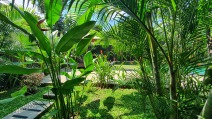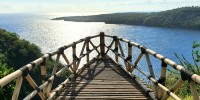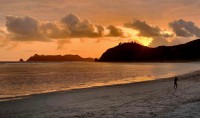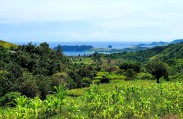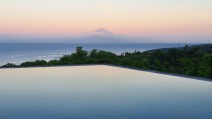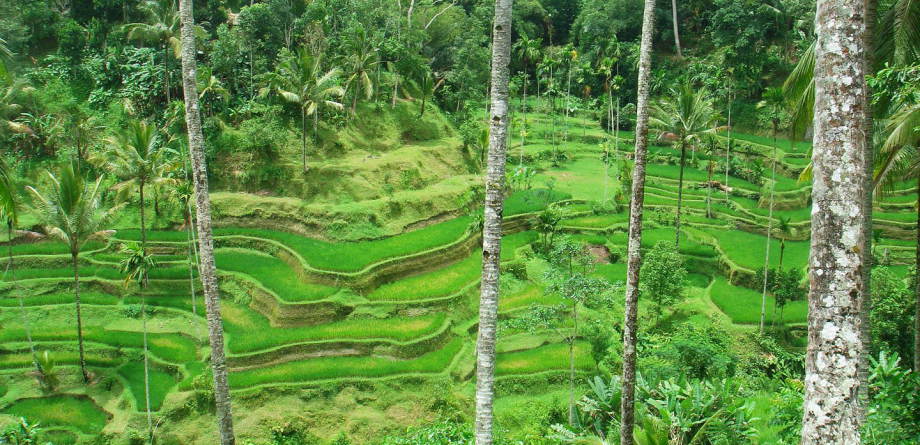
Bali - The island of the gods
Location
The island of Bali is part of the Republic of Indonesia and is located 8 to 9 degrees south of the equator between Java in the West and Lombok and the rest of the Lesser Sunda Islands (Sumbawa,
Flores, Sumba, and Timor) in the East.
The island of Bali is a real haven of peace. With a safe and calm political context, mild climate in all seasons, white sand beaches, 10,000 temples, its interesting culture, the tropical jungle, and
especially the hospitality of the Balinese, it is not surprising that many people choose to spend their holidays in Bali.
Bali is a clear example of co-existence between cultures, landscapes, and tourism development. Moreover, a holiday in Bali is within the reach of all purses.
Geography
The island of Bali has an area of only 5,632 square kilometers (2,175 square miles) and measures just 55 miles (90 kilometers) along the north-south axis and less than about 90 miles (140 kilometers)
from East to West. Because of this, it's no problem to explore the island on day tours. You can go wherever you want on the island and return to your hotel or villa in the evening.
The island is famous for its beautiful landscape. A chain of six volcanoes, between 1,350 meters and 3,014 meters high, stretches from west to east. There are lush tropical forests, pristine crater
lakes, fast-flowing rivers and deep ravines, picturesque rice terraces, and fertile vegetable and fruit gardens. The beaches in the South consist of white sand, and beaches in other parts of the
island are covered with gray or black volcanic sand.
Flora
The wide variety of tropical plants is surprising. You'll see huge banyan trees in villages and temple grounds, tamarind trees in the North, clove trees in the highlands, acacia trees, flame trees,
and mangroves in the South. In Bali grow a dozen species of coconut palms and even more varieties of bamboo.
And there are flowers, flowers everywhere. You'll see (and smell the fragrance of) hibiscus, bougainvillea, jasmine, and water lilies. Magnolia, frangipani, and a variety of orchids are found in many
front yards and gardens, along roads, and on temple grounds. Flowers are also used as decorations in temples, on statues, as offerings for the gods, and during prayers. Dancers wear blossoms in their
crowns, and even the flower behind the ear of your waitress seems natural in Bali.
Climate
You can expect pleasant day temperatures between 20 to 33 degrees Celsius year-round. From December to March, the West monsoon can bring heavy showers and high humidity, but usually, days are sunny
and the rains start during the night and pass quickly. From June to September the humidity is low, and it can be quite cool in the evenings. During this time of the year, you'll have hardly any rain
in the coastal areas.
Population
Bali's population has grown to over 3 million people the overwhelming majority of which are Hindus. Most people live in the coastal areas in the South, and the island's largest town and
administrative center are fast-growing Denpasar with a population of now over 370,000. The villages between the town of Ubud and Denpasar, Kuta (including Jimbaran, Tuban, Legian, Seminyak,
Basangkasa, etc), Sanur, and Nusa Dua are spreading rapidly in all directions, and before long the whole area from Ubud in the North to Sanur in the East, Berawa/Canggu in the West, and Nusa Dua in
the South will be urbanized.
Economy
This southern part of Bali is where most jobs are to be found, either in the hotel and tourist industry, the textile and garment industry, or in many small-scale and home industries producing
handicrafts and souvenirs.
Important agricultural products besides rice are tea, coffee, tobacco, cacao, copra, vanilla, soy beans, chilies, fruit, and vegetable (there are now even vineyards near the northwest coast). Bali's
fishing industry and seaweed farming provide other products which are important exports.
What makes Bali so special
There is a combination of friendly people, natural attractions, a great variety of things to see and do, a year-round pleasant climate, and the absence of security problems. And then there is Bali's
special "magic", which is difficult to explain.
As soon as you step off the plane you might sense the difference. In the villages, you'll notice the quietness and wisdom in old people's faces and the interest and respect in the young's. Old men
sit at the roadside caressing their fighting cocks. Beautifully dressed women walk proudly through rice fields and forests carrying offerings on their heads to the next temple. There is the smell of
flowers, and in the distance, you hear the sound of gamelan music.
Gods and spirits have been an important part of Bali's daily life for hundreds of years. Gunung Agung – Bali's holy mountain – is internationally regarded as one of the eight "Chakra" points of the
world. This may be more than a coincidence. Watch out, the moment you feel the magic of this island, you're addicted for the rest of your life.


